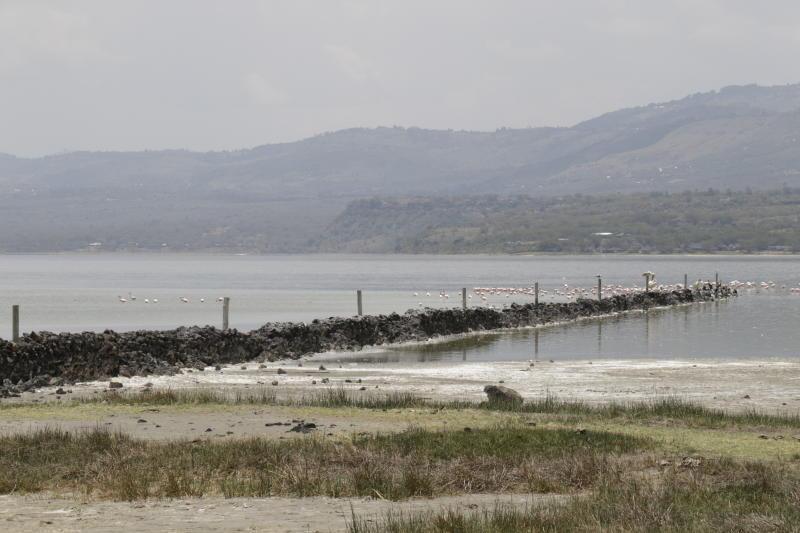Hotel construction threatens globally-acclaimed Rift Valley lake
Conservationists accuse authorities of standing by as illegal development starts choking World Heritage Site lake in Kenya

By Caroline Chebet for The Standard in Kenya
From far, flamingoes’ pink and white patterns are a sight to behold. And except for the quacks of pelicans and fish eagles perched on the heap of stones that make fences that run deep into the lake, it is all serene at Lake Elementaita in Kenya’s Rift Valley.
At a distance, children swim, savouring the warm water gushing from the legendary hot springs. Women are busy washing clothes metres away from parcels of land hived off and fenced along the shores.
“It was never like this. There were vast shores without fences and children used to run around unhindered,” Susan Mwangi, a resident, says.
Massive developments, including hotels, are coming up fast around the lake over the past few years.
Most Kenyans, and especially locals, know little about Lake Elementaita, the beautiful mass of water visible from the country’s main east-west highway. Not many know that besides being an Important Bird Area, it is also a wetland that commands international protection and is a World Heritage Site forming part of Kenya Lake System.
Lake Elementaita was designated an Important Bird Area in 1999 by Birdlife International and a Ramsar Site in 2005 by the Ramsar Convention Secretariat, an intergovernmental treaty that pushes for the conservation and wise use of wetlands and their resources
It was named a World Heritage Site in 2011 by Unesco World Heritage Centre.
But despite enjoying protection from local and international laws and falling under several government agencies, the lake has no office even as multi-million pound developments take up its shores.
Conservation concerns have since been raised to the World Heritage Committee over increasing interest by hoteliers around Lake Elementaita.
But who takes the blame when a riparian area is ripped off, threatening the fragile ecosystem? When the management plan is still a draft?
“Encroachment is the main challenge. It is a serious threat,” Kanyike Sena, a member of UN Permanent Forum on Indigenous Issues said.
If not addressed, the threats might lead the lake’s conservation status being downgraded or worse, being stripped off its status, conservationists warn.
“The recognition is a privilege. A site under intense pressures risks losing its status,” John Chumo, the National Environmental Complaints Committee secretary says.
According to the lands coordinator at the local county, Nakuru, Frank Kibelekenya, the National Lands Commission has since earmarked affected parcels on the lake that have been encroached and written to ‘invaders’ to vacate the land.
“But nothing is happening,” Mr Kibelekenya said. “Lake Elementaita is a World Heritage Site protected by local and international laws, but the greatest challenge lies on who among the many agencies is supposed to manage it.”
To protect the lake, there is need to harmonise laws that contradict each other on riparian distance. Almost all the nine laws on riparian areas vary on distance.
The lake, Kibelekenya says, should enjoy protection of the national government.
“A number of hotels have since come up on riparian land. Before any construction comes up, the National Environmental Management Authority (Nema) should give a licence and the Water Resource Management Authority (Warma) should be consulted,” he says.
The Lake Elementaita Boundary Survey report blames the confusion on 1950 maps that did not put into consideration riparian land. Almost three quarters of the lake falls under a private land. The report was drafted in 2016 under a project funded by KWS and Unesco to identify and map the riparian and boundaries around the lake.
In 2010, the government established Lake Elementaita Wildlife Sanctuary to protect and conserve birdlife and associated habitats around the water body. The following year, the lake was listed as a World Heritage Site under the Kenya Lake System.
On January 31, this year, National Museums of Kenya wrote a letter to World Heritage Centre on the Conservation of the Kenya Lake System. Detailed in the report was the draft management plan.
The issue was addressed in July in Baku, Azerbaijan, where the committee put Kenya on the spot over its failure to strengthen protection of areas between Lakes Nakuru and Elementaita as well as ensuring removal of illegal developments and restoring affected areas.
The committee also observed that Kenya was yet to develop and implement strict and clear regulations to prohibit developments in close proximity to fragile habitats and in the critical buffer zone.
Kenya is expected to submit a progress report to the World Heritage Centre by February 1, 2020 and an updated report on the state of conservation of the property and the implementation by December 2021.
But even as questions are raised over the government’s seriousness to conserve the lake, the sanctuary still lacks administration offices and staff houses, according to the draft of the 2017-27 sanctuary management plan.
Conservationists say challenges facing the world heritage sites boils down to little knowledge about their local and international importance.

This article is reproduced here as part of the Giants Club African Conservation Journalism Fellowships, a programme of the charity Space for Giants and supported by the owner of ESI Media, which includes independent.co.uk. It aims to expand the reach of conservation and environmental journalism in Africa, and bring more African voices into the international conservation debate. Read the original story here

Join our commenting forum
Join thought-provoking conversations, follow other Independent readers and see their replies